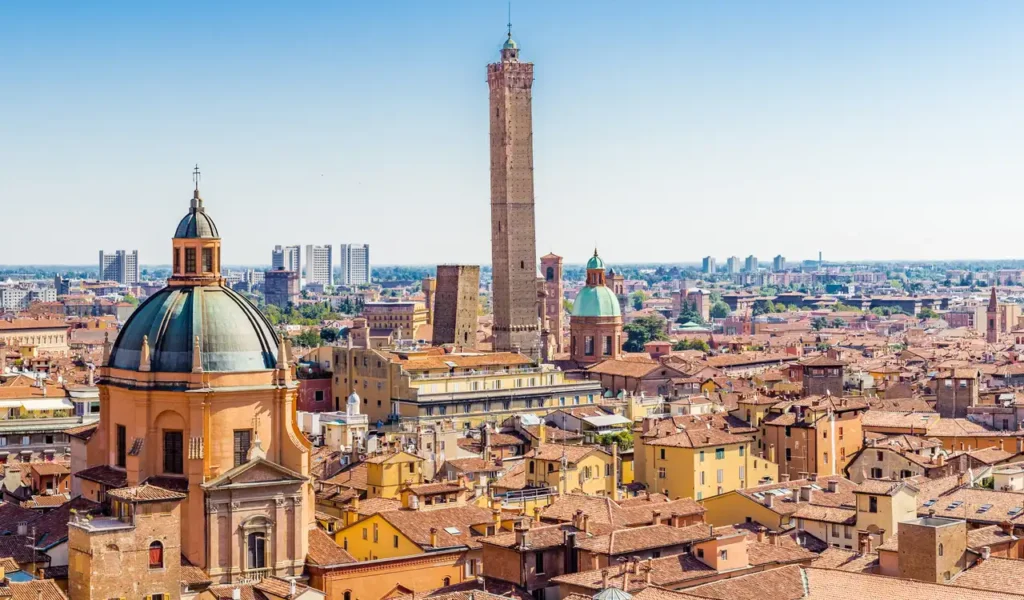
The Towers of Bologna were built between the 11th and 13th centuries. It’s believed that they were constructed by the richest families, who used them for defensive, ofensive and surveillance purposes during the Investiture Controversy. Later, they became a symbol of power for the families.
In the 19th century, the first historian to study the towers of Bologna, Giovanni Gozzadini, based on the analysis of civic archives or real estate deeds, estimated around 180 towers. More recent studies estimates the number to between 80 and 100 towers, where not all towers existed at the same time.


There are no records of new towers being built from the 14th century on and they gradually fell into oblivion. During the years that follow, some collapsed, some were demolished before collapsing. The last demolitions occurred during the restructuring plan for the city, in 1917. Two towers were demolished then: the Artenisi and the Riccadonna Towers at the Mercato di mezzo.
Towers of Bologna today
After all these years only 22 towers survived. These are some of the remaining towers of Bologna:
Alberici Tower
At 27 meters high, since 1273 it has been the seat of Bologna’s oldest trading post. It was restored in 1926.
Asinelli Tower
At 97 meters high, it’s the tallest medieval tower in Italy and one of the oldest. Along with its neighbor Garisenda, it’s the most famous tower, considered a symbol of Bologna. Due to a fire in 1398 that destroyed its interior and damaged the selenite walls at the base, masonry stairs and a 30 meters high vault were added to prevent similar problems.
On October, 2023, the tower was closed to visitation due to the leaning of its neighbor, Garisenda, that is in danger of collapsing.
Azzoguidi Tower
Aso known as Altabella, it’s 61 meters high. Its believed that it was higher in the past. In the 20th century it was renovated to improve its stability and restore it to its original medieval appearance.
Clock Tower
Overlooking the Piazza Maggiore, on the medieval side of Palazzo d’Accursion, it’s 46 meters high and was remodeled several times over the centuries. It owes it’s name to the large clock placed on it in 1451. The old clock was replaced in 1773 and, between 1885 and 1887, the tower was restored to it’s medieval appearance.
Garisenda Tower
The leaning tower of Bologna, at 47.5 meters high, is one of the most popular towers along with its neighbor Asinelli. It was originally 60 meters high but, because of its steep inclination, the town council decided to put it down. However, the idea of demolishing was abandoned and, in 1353, 12 meters of the tower were cut down. Unfortunately, the inclination of the tower is critical now. The whole area around the tower is closed and the city council is trying to find a solution to stabilize the tower.
Galluzi Tower
This is believed to be the last noble tower to be built in Bologna. It was built in 1257 overlooking the court. It was initially designed to have the same height as the Asinelli. It’s 31 meters high today.
Predinparte Tower
Also known as Coronata, it’s 59.5 meters high. The interior has 12 floors including former prisons, dining room and the terrace, which has a great view of Bologna.
Scappi Tower
Located at Via Indipendenza, it’s 38.4 meters high. It’s believed that it was planned to be higher, due to the thickness of the walls at the base.
Lambertini Tower
It’s 25 meters high and was built in the 12th century. In the 14th century it was turned into a women’s prison. In 1356, the first public mechanical clock of Bologna was installed in the tower.
Uguzzoni Tower
This is the most preserved tower in Bologna. It’s 32 meters high. In the 16th century, the tower was part of the Jewish ghetto, that was created by Pope Paul IV so the Jews wouldn’t have contact with the rest of the city population. The tower was restored in the 2010s.



